Our friends at Heritage Capital Research published a missive on this past Monday that nicely documented my observations from the past couple of weeks, that the S&P companies that have thus far reported for Q1 have far surpassed the very gloomy forecasts that have dominated the financial headlines for the past couple of months until about a week ago. But since, as of last Friday, we were only less than 20 percent into Q1 reporting, I thought it would be interesting to wait one more week to see if this HCR analysis still holds up. What do you think? Does it?
The Best Recession Ever!
By Dave Moenning on Apr 29, 2019 06:57 am
I'm not sure who I borrowed the title of this week's missive from, but I think we all have to admit that this is probably the best recession/slowdown ever!
Instead of the economy flirting with negative growth in the first quarter, which, if you will recall, had become the common expectation as the calendar was flipping from 2018 to 2019, we learned Friday that Q1 GDP came in well above expectations at 3.2%. This despite the now long-forgotten government shutdown subtracting approximately 0.3% from the total. Wow, talk about a surprise to the upside.
Instead of the U.S. succumbing to what has become a widely recognized global slowdown, which for the record, appears to be, at the very least, entering a bottoming phase, our economy put in the best first quarter in four years.
Instead of the much ballyhooed "earnings recession" that so many have been calling for in Q1, Corporate America appears to be doing what it does best - make money. Oh, and according to CNBC, 77% of S&P 500 companies reporting so far have beaten earnings estimates and 56% have exceeded analysts' expectations on the revenue side.
Yes, the earnings season is still young and the current "beat rates" are a far cry from some of the recent earnings parades, that can only be described as gangbusters. But given that the current beat rates are said to be largely in line with historical norms, investors will take this kind of a slowdown any day of the week.
Instead of the stock market fretting about the recession and the earnings decline that everyone was calling for a couple months back, both the NASDAQ and the S&P 500 hit fresh new all-time highs last week. This has left the bears frustrated and wondering what the heck happened to that "retest" that everyone was so sure of back in January and February.
Speaking of our furry friends, the folks wearing their bear caps are quick to point out that Friday's GDP report wasn't all lollipops and rainbows. No, it turns out that the consumer spending and capex (business capital expenditures) components of the GDP report were surprisingly weak. For example, personal consumption expenditures (aka the all-important PCE) posted a 1.2% annual gain, which is a punk number to say the least, and the weakest reading in a year.
On the business front, capex rose at a 2.7% annual rate, which, according to Ned Davis Research, was half the pace of the previous quarter.
Oh, and residential investment actually fell at a 2.8% rate, which marks the fifth consecutive decline.
Stocks Up. Bond Yields Down. Wait, what?
The above referenced batch of weaker-than expected data from the GDP report likely was responsible for the drop in 10-year T-Note yields. I know what you are thinking; how can stocks go up and yields go down on the same report?
The answer is simple. Different strokes for different folks/traders.
Headline GDP growth (which could always be adjusted in the next two months) supports the idea that the good 'ol USofA is NOT at risk of recession anytime soon. And with the Fed, the ECB, China, and the BOJ all talking nice these days, stock market investors can look ahead to brighter days. Days without the threats of a hostile Fed and/or inflation.
Yet, at the same time, the bears are right to a degree as some of the data was definitely not lollipops and rainbows. Thus, yields fell as bond traders focused on the narrative that consumer spending is heading the wrong direction (a result of the government shutdown and Mueller turmoil, perhaps?) and capex wasn't great.
Goldilocks Lives
But from my seat, the important storyline here is it appears Friday's report can be placed in the Goldilocks category. As in not too hot to cause the Fed to change course (again). And not cold enough to create consternation about a recession on the horizon. Nope, this report was "just right" if you are looking ahead to sustained economic growth and an ongoing stream of corporate profits.
Some argue that this is not a "Party On Wayne" situation. Or is it? The S&P finished at an all-time high after the report. Inflation is not a concern. Rates remain low. The economy is growing better than expected. Earnings appear to be doing just fine, thank you. The current rally is hated by many and skeptics about the future abound (which is a good thing from an investing sentiment perspective). And I can argue that consumer spending will perk back up now that the government shutdown is a fading memory and the Mueller report is finally out. All good, right?
Yes, yes, I do understand that stocks are overbought and that the current pace of advance is unsustainable. I recognize that the "sell in May and go away" period begins next week. And I will certainly agree that a pullback of some form is due at some point soon.
However, the bottom line is as long as money needs to be "positioned" in stocks (See my review of Marko Kolanovic's work on the subject here) the dips will likely continue to be bought and those waiting for the so-far elusive pullback will continue to be disappointed.
No, trees don't grow to the sky. And a garden-variety pullback is to be expected. I'm simply saying if there is still a big batch of money that needs to be invested, the current "buy the dip - ANY dip" environment could persist.
And as far as slowdowns go, I too will take this one every time.
Weekly Market Model Review
Now let's turn to the weekly review of my favorite indicators and market models...
The State of the Big-Picture Market Models
I like to start each week with a review of the state of my favorite big-picture market models, which are designed to help me determine which team is in control of the primary trend.
The Bottom Line:
- The Primary Cycle board upticked again this week as my Intermediate-Term Market Model finally gave up the ghost on overbought concerns and flipped to positive. The message from this board is clear: Investors should stay seated on the bull train.
This week's mean percentage score of my 6 favorite models advanced to 84.7% from 74.6% last week (Prior readings: 58.0%, 49.5%, 47%, 50%, 47.9%, 45.4%) while the median improved to 86.7% from 81.8% last week (Prior readings: 65.9%, 50%, 50%, 50%, 50%, 46.3%).
The State of the Trend
Once I've reviewed the big picture, I then turn to the "state of the trend." These indicators are designed to give us a feel for the overall health of the current short- and intermediate-term trend models.
The Bottom Line:
- For the fourth consecutive week, the Price Trend board scored a perfect 10.0 reading. This isn't exactly surprising given the fresh move to all-time highs for the S&P 500 and the NASDAQ last week. But given that the "Sell in May and go away" period is fast approaching, stocks are overbought, and confirmation among the major indices is lacking, a great many analysts/pundits are growing worried about the next, inevitable pullback. As some sloppy action would not be surprising at some point soon.
The State of Internal Momentum
Next up are the momentum indicators, which are designed to tell us whether there is any "oomph" behind the current trend.
The Bottom Line:
- The Momentum board remains in good shape. And while it may be a mistake to fret too much about indicators not being as positive as I'd like to see at this stage, the volume relationship indicators continue to give me pause. My take is that the slow and steady repositioning into equities by hedge funds and systematic traders is to blame here. But the less than stellar readings here is something to watch going forward.
The State of the "Trade"
We also focus each week on the "early warning" board, which is designed to indicate when traders might start to "go the other way" -- for a trade.
The Bottom Line:
- The message from the Early Warning board is simple: The board continues to wave a yellow flag warning of the potential for some kind of pullback/corrective action.
The State of the Macro Picture
Now let's move on to the market's fundamental factors - the indicators designed to tell us the state of the big-picture market drivers including monetary conditions, the economy, inflation, and valuations.
The Bottom Line:
- The Fundamentals board, which usually is slow to change, saw modest improvement again last week. We got some additional improvement in the economic and monetary models, and one of the component indicators in our valuation composite also upticked . As I've been saying, the Fundamental board continues to favor the bulls.
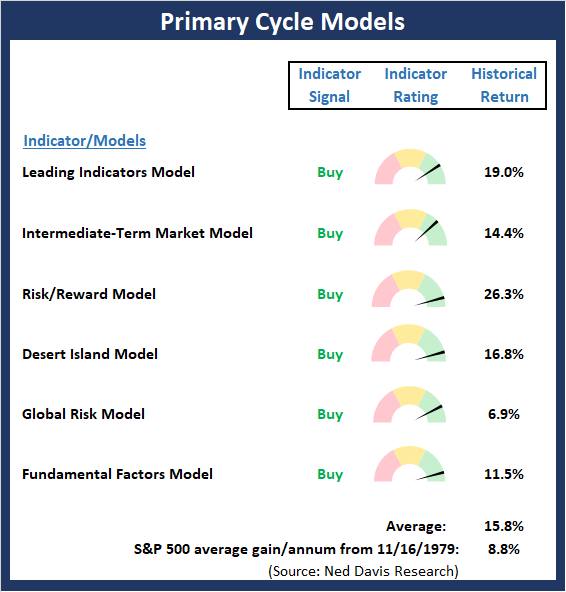
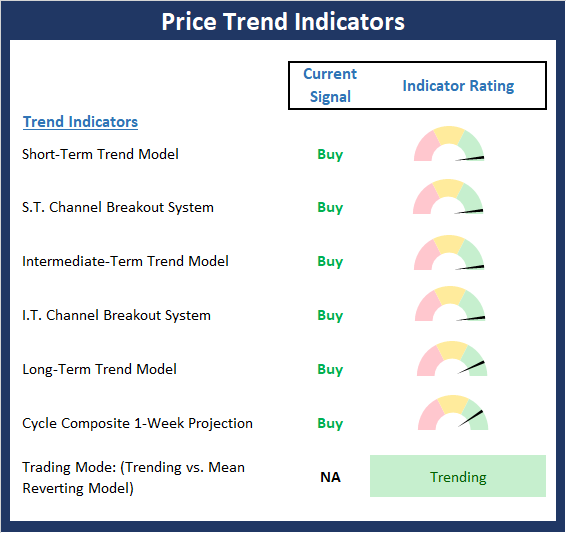
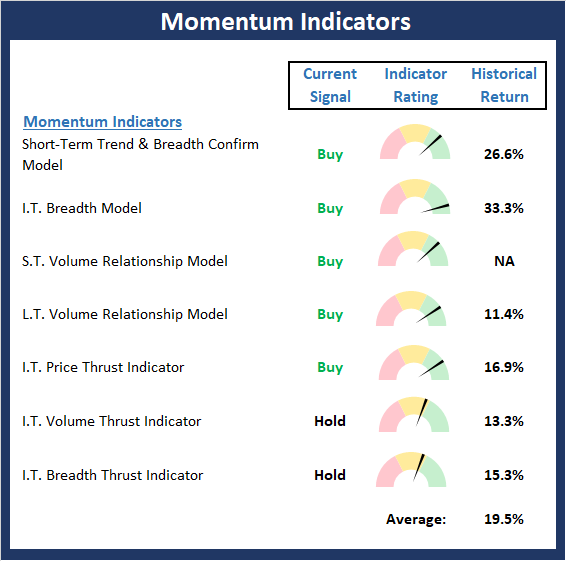
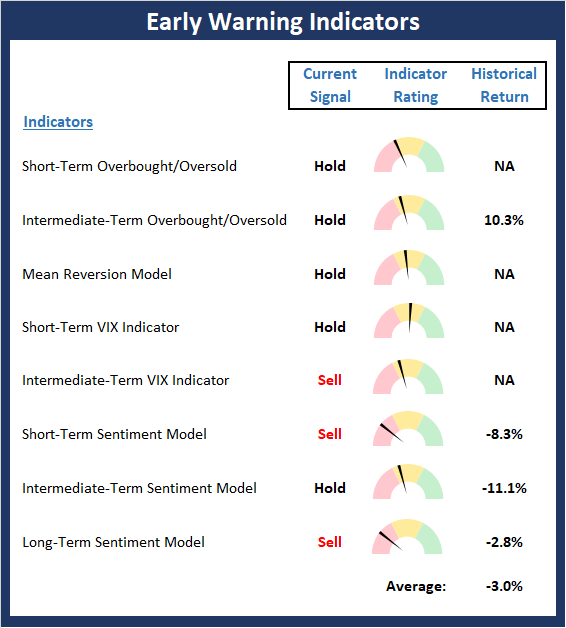
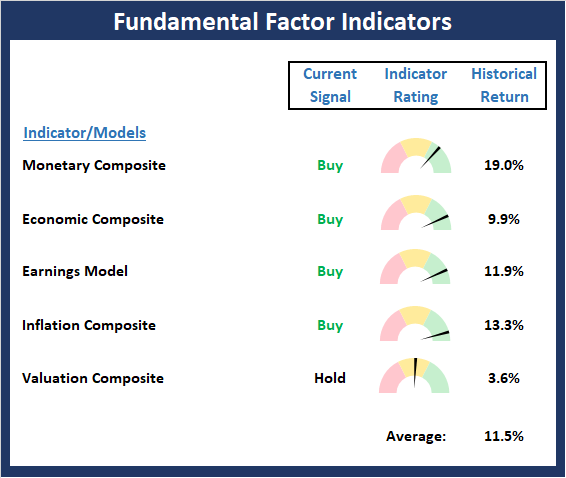
No comments:
Post a Comment